Philodendron paraiso verde is admired for its variegated marble-like foliage.
But, if your Philodendron plant does not appear glossy or attractive, you must stick to a care schedule.
If you want to leverage the Philodendron paraiso verde for every aesthetic and purifying benefit, do not end this article until you complete it.
Table of Contents Show
Overview of Philodendron Paraiso Verde
This highly in-demand tropical true climber has elongated heart-shaped leaves with exquisite colors that stay bright throughout the year, not affected by the seasons passing by.
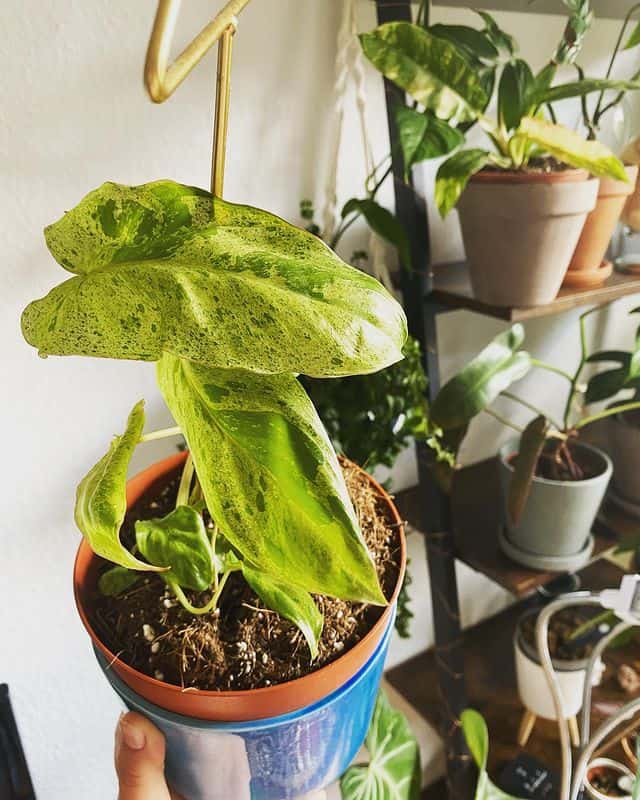
Here is the table that enlists the basic details of Philodendron paraiso verde.
| Indicator | Identity |
|---|---|
| Scientific Name | Philodendron paraiso verde |
| Common Name | Marina Ruy Barbosa, Green Paradise |
| Native | America and West Indies |
| Family | Araceae |
| Plant Type | Evergreen perennial |
| Growth Size | 10-15 inches |
| Grown For | Attractive marbled variegation in shades of creamy white |
| Foliage Type | Heart shaped beautiful variegated foliage with each leaf 8-10 inches in length |
| Flowering | Green-white flowering spathes |
| Toxicity | Mild to moderate toxic for cats and dogs |
In general, Philodendrons rarely bloom indoors. It may flower outside, but it will take several years.
Philodendron Paraiso Verde for Sale
It’s good news for all Philodendron lovers as I have found a few sellers selling paraiso verde to get your plant on your doorstep.
| Buying Options | Delivery |
|---|---|
| Aroid Nursery | Delivery within 1-3 weeks |
| Peace, love and Happiness | Delivery within 2-3 days |
| Aroid market | Delivery within 1-2 weeks |
Philodendron Paraiso Verde- Complete Grow & Care Guide
Paraiso verde climbs tree trunks in their natural tropical jungle habitat, so the most uncomplicated strategy is to create a tropical climate for the plant.
Let’s check the quick care manual.
| Parameters | Favorable Conditions |
|---|---|
| Sunlight Location | 6-8 hours of bright indirect sunlight East and South facing window |
| Watering | In the spring and summer, once a week. Once 1-2 week in winter |
| Humidity | > 65% |
| Temperature | 65º– 85ºF / 17º – 29ºC |
| Soil type | Moist, well-drained soil with pH level of 5.0 to 6.0 |
| Fertilizer | NPK in the ratio of 20:20:20 Once a month in summer. |
| Repotting | Once every year or every 2 years |
| Pruning | Once every few weeks in summer or spring |
| Propagation Methods | Stem cuttings, Air layering and Root division |
| Pests | Aphids, scales, and spider mites |
| Diseases | Xanthomonas Leaf Spots or Blights, Pseudomonas Leaf Spots and Blights, Erwinia Leaf Spot, Blight, Stem Rot, and Soft Rot |
1. Sunlight & Temperature
Paraiso Verde is a moderate light-loving plant that thrives best in bright indirect sunlight for at least 4-5 hours daily with a temperature of 65° to 85° F.
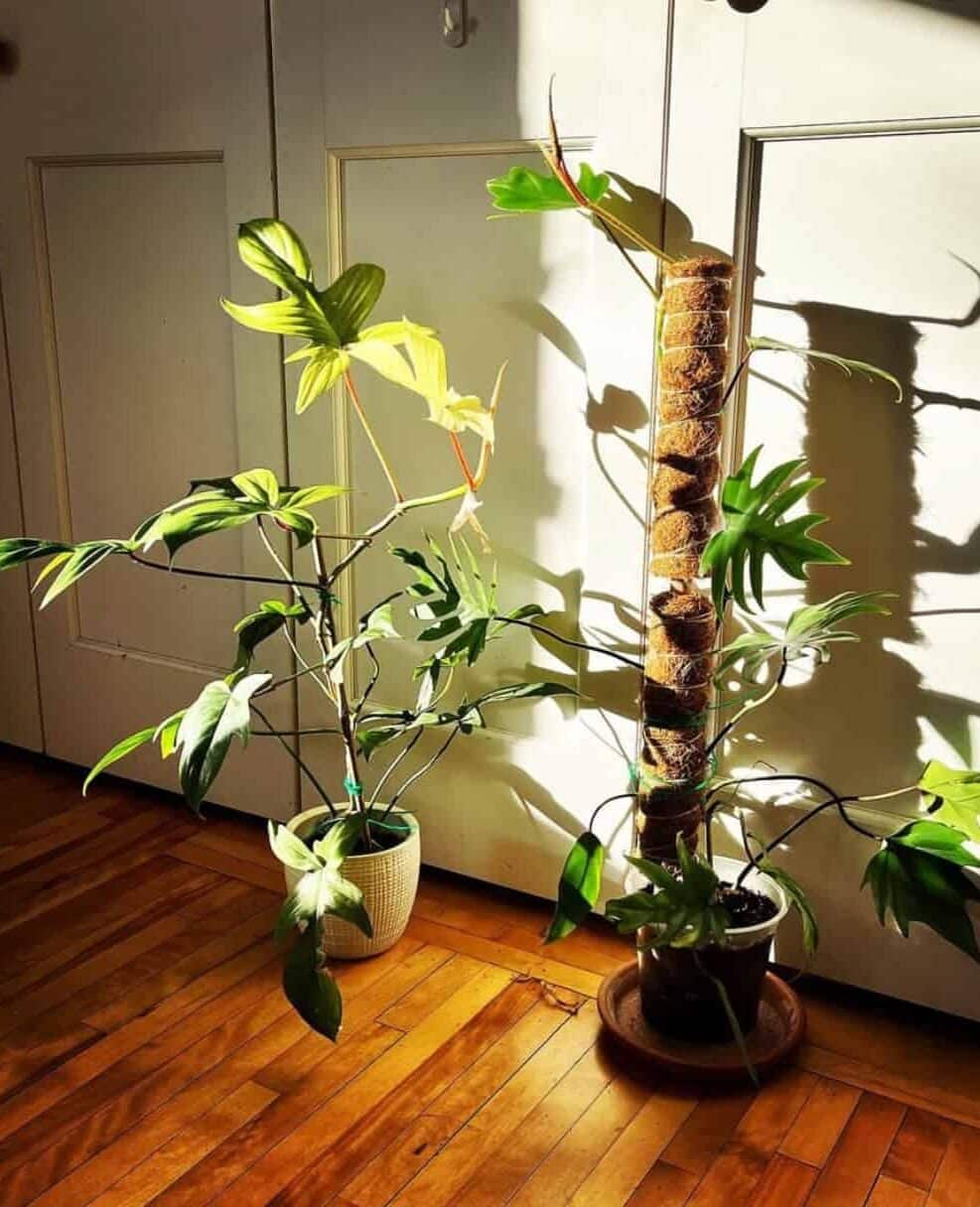
If the intensity of sunshine is not balanced, Philodendron Paraiso Verde can show several unexpected symptoms.
| Low Light Problems | Excessive Sunlight Problems |
|---|---|
| It causes stunted growth or grows very slowly. | It ruins their beautiful variegation pattern. |
| Discoloration of green leaves to pale yellow. | It burns its leaves. |
| The stems grow with long spaces between the leaves or leaf nodes. | Overheating of plant containers makes soil dry and eventually die. |
However, if the temperature falls below 65°F, the plant may generate less foliage and grow irregularly.
This plant may also be more vulnerable to infection.
Tips to Provide Proper Light & Temperature
- Place the plant under sunlight 3-5 feet from the south-facing windows. East facing window is the best during the morning.
- Put in a bright room behind drapes to minimize direct light striking the leaves.
- Also, you can use grow lights for at least 10-12 hours during the cold season or in the frosty regions.
- In the winter, bring the outdoor plant container inside and drape it in a blanket plant cover to keep it warm.
- If the temperature is high enough, follow a regular watering plan to moisten the soil.
2. Watering & Humidity
Water Philodendron paraiso verde with 0.8 cups weekly when the soil’s top is 2-3 inches (5-7.6 cm) dry.
Moreover, provide them with humidity between 60% and 70%.
Water your plant with chlorine-free distilled water. If you’re using tap water, use it after leaving it overnight.
This procedure allows the excessive chlorine and other minerals to settle down before pouring this water into your plant.
Here are a few indicators of incorrect watering.
| Overwatered Signs | Underwatered Signs |
|---|---|
| Plants close stoma pores to halt evaporation, resulting in wilting Wilted leaves are dry and crispy | It damages the roots that can't absorb water, so leaves start to wilt. Wilted leaves are soft and limp |
| Stunted growth or smaller new leaves growth than usual leaves | Fowl smell |
| Leaves have dry edges and curled leaves | Attacked by fungal diseases and pest |
| Discoloration of leaves | Roots decay and rot |
Tips to Maintain Proper Watering & Humidity
- Add water until you see it coming out of the bottom openings of the pot. If you notice any water accumulating at the bottom, you can stop.
- Monitor the soil moisture condition by using a moisture meter.
- Do not mist too much water on its leaves because they can absorb enough water through roots.
- Use a room humidifier instead.
3. Soil & Fertilization
For Philodendron paraiso verde, you must invest in high-quality, nutrient-rich soil, a loamy, moist, well-drained soil that ranges in pH from 5-6.
Moreover, this plant requires a balanced NPK fertilizer every 4 weeks in spring and summer and every 6-8 weeks in fall and winter.
You must identify the condition of your soil if your Philodendron has received inadequate or excessive fertilization.
| Under-fertilization | Over-fertilization |
|---|---|
| Slow growth and unusual size of leaves | Vulnerable to pests and diseases |
| Weak roots | Burnes or dried leaves margins |
| Pale new leaves indicate a deficiency of Calcium and Potassium | Wilting and collapse or death |
| Leggy growth | Salt buildup on the soil surface and roots |
Tips for Proper Soil & Fertilization
- Use Miracle-Gro Indoor Potting to boost the growth of your plants.
- Avoid using garden soil because it may contain insects and pathogens susceptible to diseases.
- Prepare your potting mix with 4 parts coconut coir + 2 parts of orchid bark+ 1 part activated charcoal+ 1 part perlite+ 1 part pumice+ 1 part worm castings.
- If you use commercial liquid fertilizer, dilute in 1/4 strength.
4. Biennial Repotting
The best season to re-pot your plant is during the spring season, once every two years. However, avoid doing it during winter.
When the plant roots grow large and begin to emerge from the drainage hole, realize its the time to repot them.
Repotting requires basic tools, such as Gardening gloves, Pruning shears, and Watering cans.
I highly recommend you take a pot at least 2 inches (5 centimeters) larger than the one before. Refill the pot with the appropriate soil mix when you’re finished repotting.
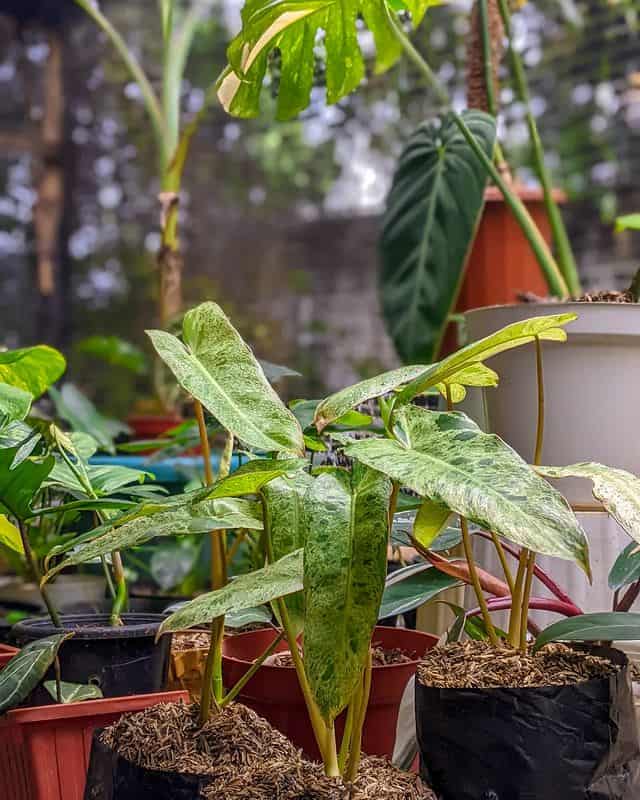
Immediately after repotting, check the Philodendron Paraiso plant for signs of distress.
Philodendron paraiso verde grows in any container. Still, a glazed ceramic pot or terracotta pot diameter of one to two inches greater than the root ball of your plant is the best.
Steps to Re-pot Philodendron Paraiso Verde
- Gently pat the plant pot and use a sharp, sterile tool to remove the soil without injuring the plant roots.
- Remove the plant from its pot slowly and examine the roots after removing the soil.
- If you find damaged roots, cut and remove them.
- Fill the new pot hallway with fresh soil and set the plant in it.
- After adding soil to the remaining half, water your newly potted plant.
- Before repotting, check if your new pot has a proper drainage system. If it is, don’t worry plant will be fine.
Tips for Repotting
- You must avoid garden soil to repot your plant. It must be fresh as the fresh soil is more fertile than used soil and free of contamination and disease.
- After repotting, remember to water the plant and keep the soil consistently moist.
- You can apply a mild liquid fertilizer to the plant when repotting.
- Repotting shouldn’t be done in the winter because of the low light and temperature.
- Continue with the usual maintenance requirements after repotting.
5. Occasional Pruning
Frequent pruning is unnecessary for Philodendrons, but the best time is spring.
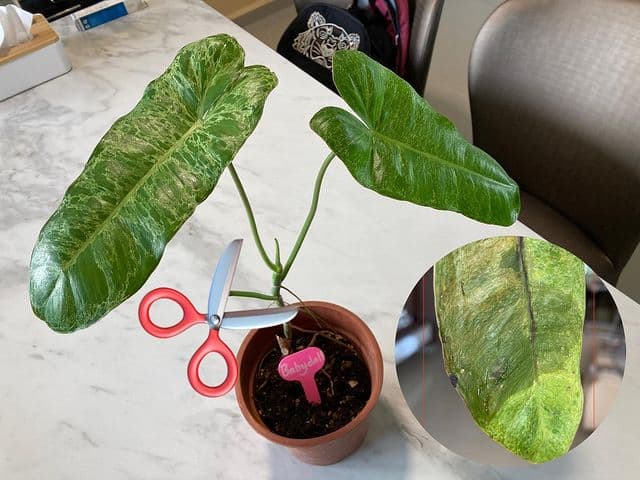
A huge, overgrown Philodendron may need pruning when pests feed on the plant. Besides, the diseased leaves and stems also show signs of plants having healthy pruning.
Philodendron Paraiso Verde frequently needs to deal with scales, aphids, mealybugs, spider mites, and white flies, among other pests.
Xanthomonas Leaf Spots or Blights, Pseudomonas Leaf Spots and Blights, Erwinia Leaf Spots, Blight, Stem Rot, and Soft Rot are the major diseases affecting plant growth.
To prune the plant, inspect all yellow, damaged leaves and longest stems and trim them with sterilized tools.
Control Measures for Pests & Pathogens
- Isopropyl alcohol can be a very effective disinfectant to wipe the infected part with it.
- A continuous infestation can be treated using Insecticidal soap and other natural insecticides.
- Different fungal infections can be successfully treated with fungicides such as Medallion (fludioxonil) and Prostar (flutolanil)
- Don’t mist the plant in the evening or frequently if the plant receives the water comfortably and the humidity is favorable.
Growth Rate of Philodendron Paraiso Verde
The Philodendron paraiso plant actively grows across USDA hardiness zones 9 to 11 and spreads to a width of approximately 15.7 to 23.6 inches (40 to 60 cm).
It grows 10 to 15 inches tall (25 to 38 centimeters), but it grows as tall as 20 inches when grown indoors.
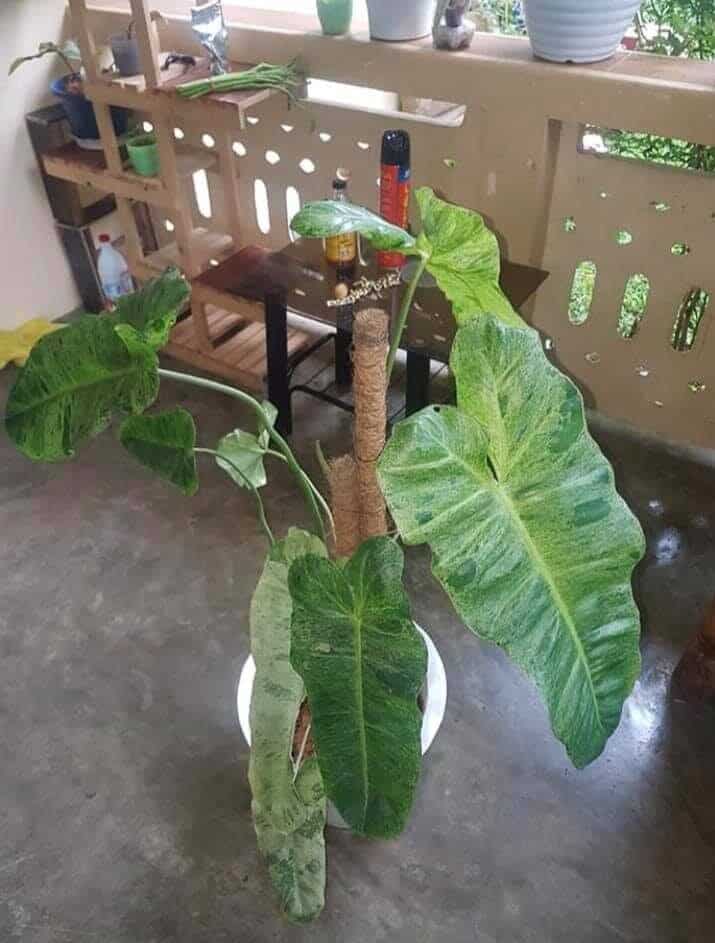
The plant proliferates if it receives the optimum care requirements. With the proper care, Philodendrons can live up to 10 years.
Depending on the plant’s care regimen, the leaves can range in length from 7 to 10 inches (17.7 to 25.4 cm) and have a marbling appearance.
These narrow, elongated, wavy, and heart-shaped leaves are first marked with white. Once the plant reaches maturity, these marble stains become pale yellow.
Philodendron paraiso verde does not bloom, so the variegated leaves are the only highlight of the plant.
Toxicity of Philodendron Paraiso Verde
Like other Philodendron varieties, it has insoluble calcium oxalates, which can be toxic to horses, cats, and dogs.
This way, Philodendron paraiso verde can be mild to moderately poisonous in humans and pets.
You could suffer severe injury from the minute calcium oxalate crystals found in leaf juice. Inflammation and some pain follow the initial ache.
Ingestion of plant leaves, leftover water, or sap may result in oral irritation, intense burning and irritation of the mouth, tongue, and lips, excessive drooling, vomiting, and difficulty swallowing.
Call at Animal Poison Control Center (ASPCA) at (800) 426-4435 if you think your pet has ingested this plant.
Propagation of Philodendron Paraiso Verde
Spring is the best time to propagate Philodendron paraiso verde.
Except for winter, you can propagate nearly any time of year.
Gardening scissors, gloves, Potting mix, and Perlite are the tools required for propagation.
1. Propagation Via Stem Cutting
Cutting off a stem is the best method to propagate this plant. You can cut the stem and multiply it when the parent plant is full and mature.
Using the stem-cutting method, you must take a few stages when propagating the Paraiso verde.
- Start by choosing the long and healthiest stem. Strong stems with a good transport system and large, lush leaves with minimal gaps between them are more likely to form roots swiftly.
- Once you’ve found the right stems, cut a piece about 3–4 inches long from the end of the stem.
- Start preparing a propagating soil mix by filling around ¾ of the pot.
- Add some rooting hormones and place the cutting in the moist soil.
Propagation In Water
- You can use a clean, sterile water-filled glass with rooting hormone.
- Place the glass of water with the stem cutting inside and keep it somewhere warm and damp.
- Place in low bright light and change the water weekly.

The roots will develop to a length of a few inches after a few weeks, then transfer the propagated stems to the new planter. But be aware that it can take the plant weeks or months to reach maturity.
2. Air Layering-Based Propagation
Air layering allows plants to develop roots from a node without soil and water.
Cling film and sphagnum moss are required for the process.
Here are the detailed instructions.
- Choose the section you want to propagate and cut at an angle of 45° wrap it in sphagnum moss using clingfilm.
- Spray with some water to help your new roots grow in a healthy environment.
- You will see the rooting system within from one week to a month.
- After a healthy root system has developed, it’s time to cut the stem and move it to its new home with the appropriate potting mix.
If you are confused about the process, here is the visual guide for you!
From Editorial Team
Conclusion!
Philodendron Paraiso Verde is a tropical plant that is easy to manage to decorate your sitting rooms or patios.
Furnish the plant with lightweight, well-drained, and aerated soil to boost their blooming.
Happy Gardening!
